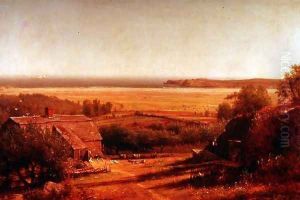Worthington Wittredge Paintings
Worthington Whittredge was a notable American artist born on May 22, 1820, in Springfield, Ohio. Growing up in a rural setting, Whittredge developed a deep appreciation for the natural landscape, which would later become a central theme in his work. Initially, he worked as a house and sign painter in his early years, a common starting point for many artists of his time due to the limited availability of formal art education in the United States. Seeking to advance his skills and career, Whittredge moved to Europe in 1849, where he spent over a decade studying and working with some of the leading artists of the era. His time in Europe was particularly influenced by the Düsseldorf School of Painting in Germany, where he was deeply impacted by the school's emphasis on detailed landscape painting and the study of nature.
During his European sojourn, Whittredge traveled extensively, including visits to Italy and Switzerland, which broadened his artistic horizons and enriched his palette. His work from this period reflects a keen observation of natural scenes, rendered with meticulous detail and a profound sense of realism. In 1859, Whittredge returned to the United States, where he became an integral part of the Hudson River School, a group of artists known for their romantic portrayal of the American landscape. His work, however, distinguished itself within the group through his incorporation of light and atmosphere, which added a lyrical quality to his depictions of the American wilderness.
Throughout his career, Whittredge was celebrated for his landscapes that captured the expansive beauty of the American West, notably after a trip to the Rocky Mountains in 1865. This journey had a profound impact on his artistic direction, leading him to adopt a more panoramic approach in his compositions. His paintings from this period, characterized by a serene and majestic portrayal of the western landscape, earned him widespread acclaim.
Whittredge's contributions to American art were recognized by his peers and art institutions alike. He served as the president of the National Academy of Design from 1874 to 1877, a testament to his standing in the art community and his commitment to nurturing the next generation of artists. Worthington Whittredge continued to paint until his vision began to fail in his later years, leaving a legacy that captured the evolving American landscape through a period of significant change. He passed away on February 25, 1910, in Summit, New Jersey, leaving behind a body of work that remains celebrated for its historical value and artistic beauty.
